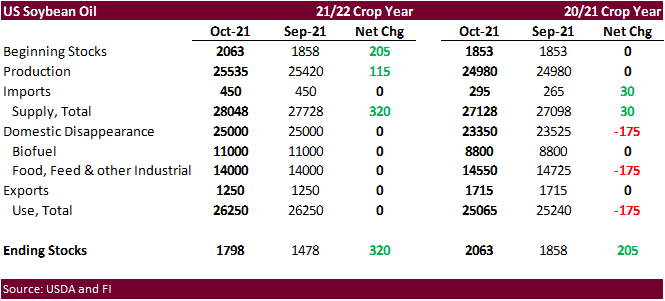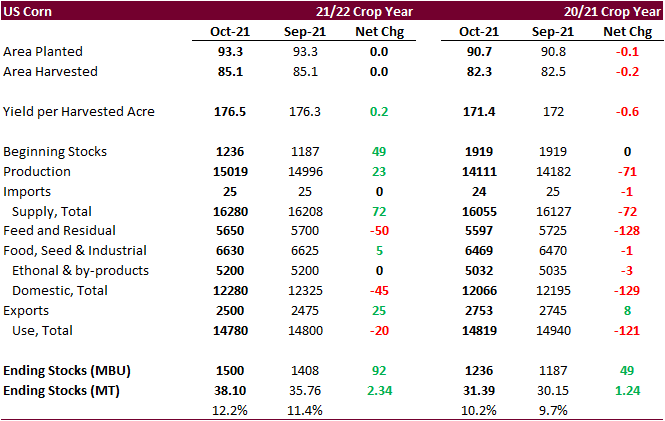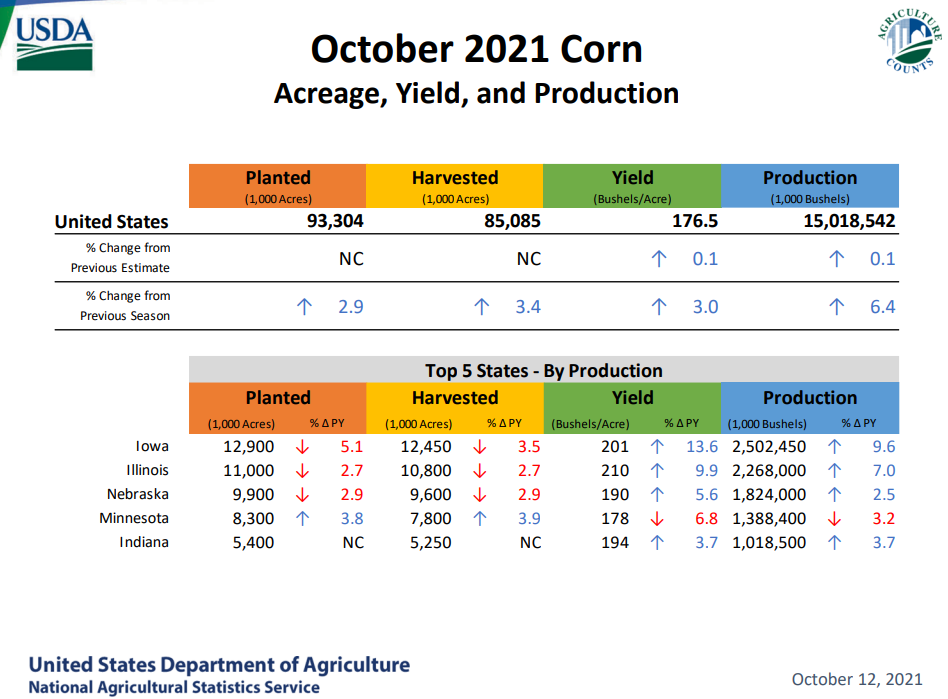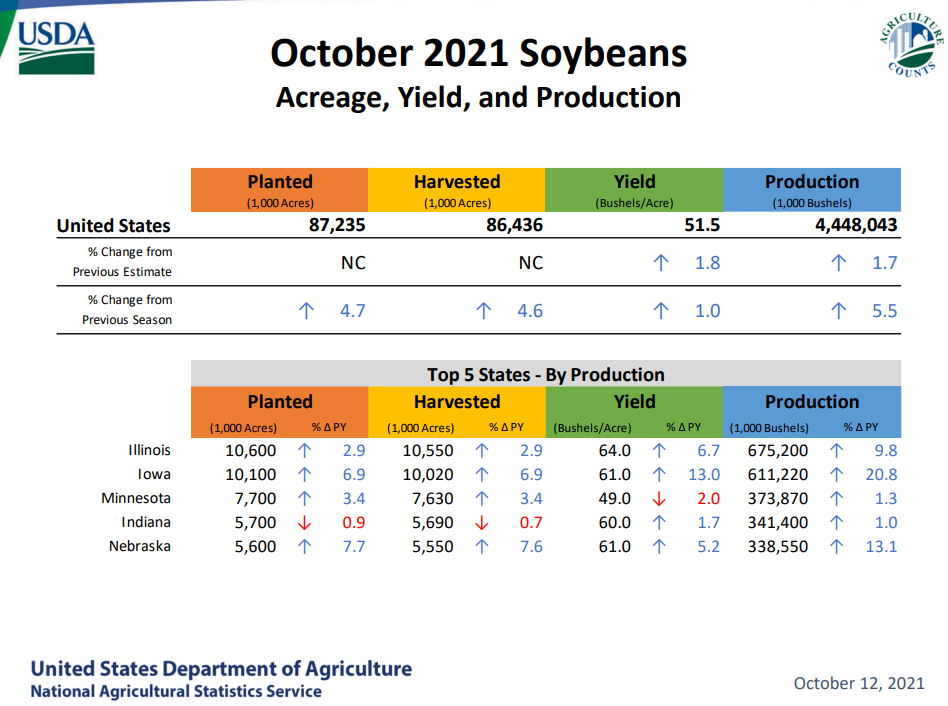PDF Attached
USDA released their October S&D and crop production reports
Reaction: Bearish corn and soybeans, neutral to slightly friendly wheat. USDA’s 2021-22 US soybean oil stocks were revised up a large 320 million pounds, and soybean oil prices naturally traded sharply lower. Soybean meal stocks were cut 100,000 short tons, triggering meal/oil spreading. We lowered our trading range projections for the soybean complex.
USDA NASS executive summary
https://www.nass.usda.gov/Newsroom/Executive_Briefings/index.php
USDA OCE Secretary’s Briefing
https://www.usda.gov/oce/commodity-markets/wasde/secretary-briefing
following the release of the report soybean prices dropped and corn followed. Wheat traded two-sided post USDA report and then trended higher in part to wheat/soybean and wheat/corn spreading. 2021 US soybean production was upward revised 74 million bushels after the USDA raised the US yield by 0.9 bu/ac to 51.5, 0.4 bu/ac above an average trade guess. There were no changes to the US harvested area for soybeans and corn. USDA increased the 2021-22 US soybean carryout to 320 million bushels, 20 million above the trade average. USDA made some adjustments to their old crop balance sheet, including the 81 million bushels increase in ending stocks per September 1 stocks (2020 upward revision to production). For this crop year, USDA increased soybean production by 74 million bushels. They lowered imports by 10 million. For US crush, USDA increased it by 10 million bushels, and increased residual by 1 million. We still think USDA is too low on 2021-22 US crush. What was interesting to see was USDA’s adjustments to old-crop soybean oil. They decided to lower food use by 175 million pounds and left unchanged soybean oil for biodiesel. We thought they would adjust lower SBO for biofuel. They took SBO 2020-21 imports up 30 million pounds and raised the end of October ending stocks by 205 million pounds to 2.063 billion, well above the 1.2-1.3 billion the trade was looking for about six months ago. New-crop SBO production was raised 115 million pounds (higher crush) to 25.535 billion, above 24.980 billion produced in 2020-21. USDA cut old-crop soybean meal ending stocks by 50,000 short tons to 400,000 (we were looking for an upward revision). They lowered old-crop exports by 200,000, raised domestic use by 175,000, took production down 55,000, and lowered imports by 20,000 short tons. For new-crop USDA raised production by 250,000 short tons and raised domestic use by 300,000 short tons, resulting in a 400,000 short ton carryout, 100,000 less than the previous month. World soybean production was revised higher by 0.7 million tons to 385.1 million, 5.4% above the previous year. World ending stocks were reported at 104.6 million tons, 3.9 million above an average trade guess, 5.7 million above the previous month and 5.5% above 2020-21.

USDA lifted the 2021 US corn yield by 0.2 bu/ac to 176.5 bushels per acre. The trade was looking for a slight decrease. As a result, US corn production increased 23 million bushels to 15.019 billion bushels. USDA increased the 2020-21 US corn carryout by 92 million bushels to 1.500 billion, 68 million above an average trade guess and 21 percent above the 2020-21 crop year. USDA made several adjustments to the old-crop US corn balance sheet, as expected per September 1 grain stocks. For new-crop, USDA lowered feed use by 50 million bushels to 5.650 billion, above 5.597 billion in 2020-21. USDA increased corn exports by 25 million to 2.50 billion for 2021-22, below 2.753 billion in 2020-21. The US stocks to use for corn is now projected at 12.2%, up from 11.4% previous month and above 10.2% for 2020-21. World corn production was raised 0.5 million tons from the previous month and stocks were lifted 4.1 million tons to 301.7 million, a 4 percent increase from previous season.

After adjusting for a lower all-wheat crop production per Small Grains Summary, USDA cut the 2021-22 US stocks by 35 million bushels to 580 million, about in line with trade expectations, and down 31 percent from last season. USDA lowered its outlook for HRW wheat stocks by 36 million bushels and SRW by 5 million, and slightly raised the other three classes of wheat. USDA’s 51-million-bushel reduction to 2021-22 all-wheat production forced them to trim the feed use by 25 million bushels. They also lowered imports by 10 million, possibly by recognizing a short Canadian wheat crop (was taken down 2MMT this month). USDA lowered world wheat production by 4.4 million tons and world ending stocks by 6.0 million tons (3.6 million more than what the trade was looking for).

Price projections revised below.
Price outlook:
December corn is seen in a $4.85-$5.65 range
March corn is seen in a $5.00-$5.80 range.
Soybeans – November $11.50-$13.00 range (down 50), March $11.50-$13.50 (down 50)
Soybean meal – December $295-$335 (down 10, unch), March $300-$360
Soybean oil – December 57-63 cent range (down 300, down 200), March 56-65 (down 200, down 200)
December Chicago wheat is seen in a $7.00‐$7.75 range, March $6.50-$7.75
December KC wheat is seen in a $6.95‐$7.80, March $6.75-$8.00
December MN wheat is seen in a $9.00‐$9.75, March $9.00-$9.75


Terry Reilly
Senior Commodity Analyst – Grain and Oilseeds
Futures International
One Lincoln Center
18 W 140 Butterfield Rd.
Oakbrook Terrace, Il. 60181
W: 312.604.1366
ICE IM: treilly1
Skype: fi.treilly

Trading of futures, options, swaps and other derivatives is risky and is not suitable for all persons. All of these investment products are leveraged, and you can lose more than your initial deposit. Each investment product is offered only to and from jurisdictions where solicitation and sale are lawful, and in accordance with applicable laws and regulations in such jurisdiction. The information provided here should not be relied upon as a substitute for independent research before making your investment decisions. Futures International, LLC is merely providing this information for your general information and the information does not take into account any particular individual’s investment objectives, financial situation, or needs. All investors should obtain advice based on their unique situation before making any investment decision. The contents of this communication and any attachments are for informational purposes only and under no circumstances should they be construed as an offer to buy or sell, or a solicitation to buy or sell any future, option, swap or other derivative. The sources for the information and any opinions in this communication are believed to be reliable, but Futures International, LLC does not warrant or guarantee the accuracy of such information or opinions. Futures International, LLC and its principals and employees may take positions different from any positions described in this communication. Past results are not necessarily indicative of future results.
